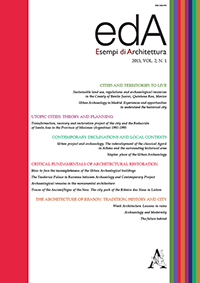Estratto da
ESEMPI DI ARCHITETTURA
International Journal of Architecture and Engineering
Archaeology and Modernity
ESEMPI DI ARCHITETTURA
International Journal of Architecture and Engineering
Archaeology and Modernity

The essay want to be an iconographic research on archaeology and its connections with modern architecture. The image of the ruin becomes a cruel representation of the time and its destructive power; the fragment as ambiguous sign shows the aspiration for an unfinished unity but also its autonomous statute; the ancient becomes an uncatchable time, the time of myth. Franco Purini writes: ‘‘the birth of Archaeology as science dissolved the meaning of antiquity as ambiguous circularity of completeness and dissolution, but no doubt a kind of disquieting objectiveness conferred to the fragment, the symbolical form of antiquity’’(Purini, 2013). The distinctive feature of this antiquarian and collecting study, summed up the splendid drawings of Joseph Michael Gandy and Giovanni Battista Piranesi, brings up another theme: the time as inexorable and selective process in which the rests of the past stratify and accumulate up a kind of museum of memory. From Villa Adriana (from architectural classification in complex structures, defined by Costantino Dardi), we can consider a lot of projects in which this idea recurs constantly in the modern architecture becoming an invariant of composition. An important Frank Lloyd Wright’s work like the Florida Southern College and The Salk Institute of Louis I. Kahn; experimental projects of Oswald Mathias Ungers; the Foro Italico’s plan; the Richard Meier’s Getty Center; the Gallaratese designed by Carlo Aymonino and Aldo Rossi; the Scarzuola of Tomaso Buzzi; the Hearst Castle of William Rundolph Hearst, designed by Julia Morgan; in these examples become central the history and its conflictual relationship with modern architecture. ‘‘At dawn of architectonical modernity there is substantially the idea of an irrepressible and destructive inclination that could reveals a kind of self-archaeological act of Modernism, or an automatic attitude to produce by itself (or in self) an idea (a building etc.,) and at the same time its ancient traces’ (Neri, 2013). Finally, by this anti-historical interpretation of modern architecture memory emerges as authentic and evocative meaning.
| pagine: | 137-144 |
| DOI: | 10.4399/978885488586812 |
| data pubblicazione: | Luglio 2015 |
| editore: | Aracne |








